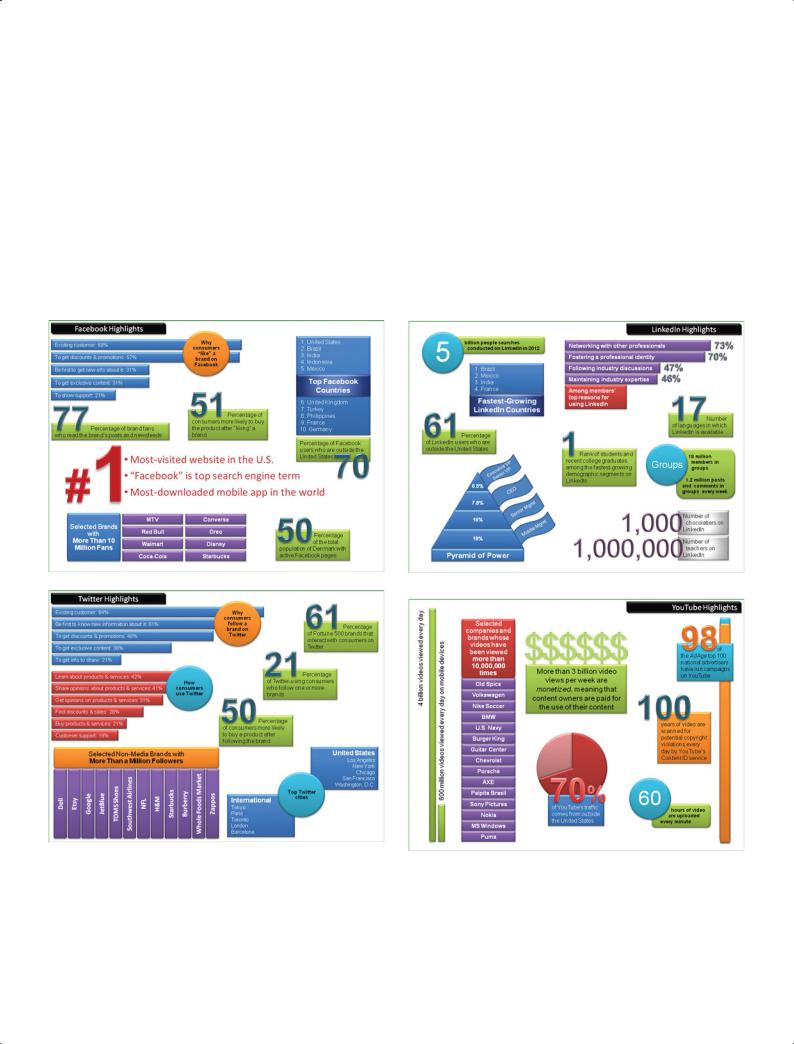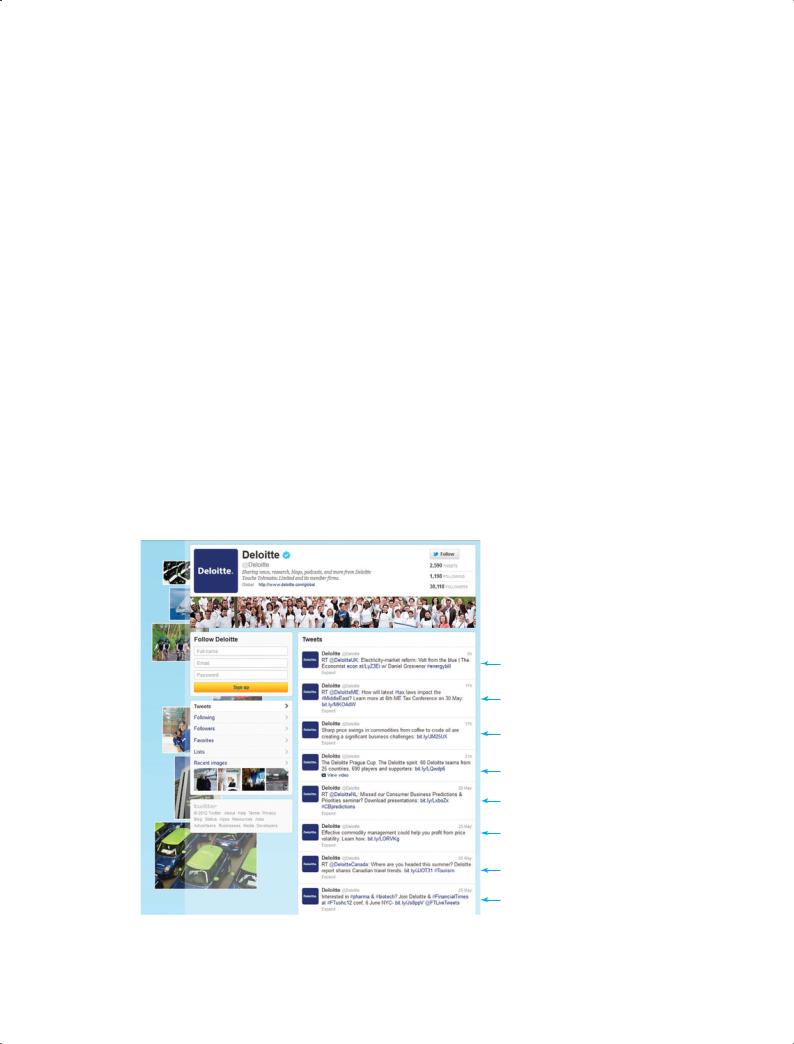
- •Understanding Why Communication Matters
- •Communicating as a Professional
- •Exploring the Communication Process
- •Committing to Ethical Communication
- •Communicating in a World of Diversity
- •Using Technology to Improve Business Communication
- •Chapter Review and Activities
- •Test Your Knowledge
- •Apply Your Knowledge
- •Practice Your Skills
- •Expand Your Skills
- •References
- •Understanding the Three-Step Writing Process
- •Analyzing the Situation
- •Gathering Information
- •Selecting the Right Medium
- •Organizing Your Message
- •Chapter Review and Activities
- •Test Your Knowledge
- •Apply Your Knowledge
- •Practice Your Skills
- •Expand Your Skills
- •References
- •Adapting to Your Audience: Building Strong Relationships
- •Adapting to Your Audience: Controlling Your Style and Tone
- •Composing Your Message: Choosing Powerful Words
- •Composing Your Message: Creating Effective Sentences
- •Composing Your Message: Crafting Coherent Paragraphs
- •Using Technology to Compose and Shape Your Messages
- •Chapter Review and Activities
- •Test Your Knowledge
- •Apply Your Knowledge
- •Practice Your Skills
- •Expand Your Skills
- •References
- •Revising Your Message: Evaluating the First Draft
- •Revising to Improve Readability
- •Editing for Clarity and Conciseness
- •Using Technology to Revise Your Message
- •Producing Your Message
- •Proofreading Your Message
- •Distributing Your Message
- •Chapter Review and Activities
- •Test Your Knowledge
- •Apply Your Knowledge
- •Practice Your Skills
- •Expand Your Skills
- •References
- •Electronic Media for Business Communication
- •Social Networks
- •Information and Media Sharing Sites
- •Instant Messaging and Text Messaging
- •Blogging
- •Podcasting
- •Chapter Review and Activities
- •Test Your Knowledge
- •Apply Your Knowledge
- •Practice Your Skills
- •Expand Your Skills
- •References
- •Strategy for Routine Requests
- •Common Examples of Routine Requests
- •Strategy for Routine Replies and Positive Messages
- •Common Examples of Routine Replies and Positive Messages
- •Chapter Review and Activities
- •Test Your Knowledge
- •Apply Your Knowledge
- •Practice Your Skills
- •Expand Your Skills
- •References
- •Using the Three-Step Writing Process for Negative Messages
- •Using the Direct Approach for Negative Messages
- •Using the Indirect Approach for Negative Messages
- •Sending Negative Messages on Routine Business Matters
- •Sending Negative Employment Messages
- •Sending Negative Organizational News
- •Responding to Negative Information in a Social Media Environment
- •Chapter Review and Activities
- •Test Your Knowledge
- •Apply Your Knowledge
- •Practice Your Skills
- •Expand Your Skills
- •References
- •Using the Three-Step Writing Process for Persuasive Messages
- •Developing Persuasive Business Messages
- •Common Examples of Persuasive Business Messages
- •Developing Marketing and Sales Messages
- •Chapter Review and Activities
- •Test Your Knowledge
- •Apply Your Knowledge
- •Practice Your Skills
- •Expand Your Skills
- •References
- •Applying the Three-Step Writing Process to Reports and Proposals
- •Supporting Your Messages with Reliable Information
- •Conducting Secondary Research
- •Conducting Primary Research
- •Planning Informational Reports
- •Planning Analytical Reports
- •Planning Proposals
- •Chapter Review and Activities
- •Test Your Knowledge
- •Apply Your Knowledge
- •Practice Your Skills
- •Expand Your Skills
- •References
- •Writing Reports and Proposals
- •Writing for Websites and Wikis
- •Illustrating Your Reports with Effective Visuals
- •Completing Reports and Proposals
- •Chapter Review and Activities
- •Test Your Knowledge
- •Apply Your Knowledge
- •Practice Your Skills
- •Expand Your Skills
- •References
- •Finding the Ideal Opportunity in Today’s Job Market
- •Planning Your Résumé
- •Writing Your Résumé
- •Completing Your Résumé
- •Chapter Review and Activities
- •Test Your Knowledge
- •Apply Your Knowledge
- •Practice Your Skills
- •Expand Your Skills
- •References
- •Submitting Your Résumé
- •Understanding the Interviewing Process
- •Preparing for a Job Interview
- •Interviewing for Success
- •Following Up After an Interview
- •Chapter Review and Activities
- •Test Your Knowledge
- •Apply Your Knowledge
- •Practice Your Skills
- •Expand Your Skills
- •References
- •Index

|
|
|
Chapter 6: Crafting Messages for Electronic Media 129 |
|||
Electronic Media for Business Communication |
1 LEARNING OBJECTIVE |
|||||
SmartPak’s choice of Facebook for customer communication may seem like an obvious |
Identify the major electronic |
|||||
media used for brief business |
||||||
move, but the use of social media represents a fundamental shift in business communica- |
||||||
messages, and describe the nine |
||||||
tion. The shift is still taking place, as more consumers adopt social media and businesses |
||||||
compositional modes needed for |
||||||
experiment with the best ways to integrate these media and to adapt their internal and external |
||||||
electronic media. |
||||||
communication practices. |
|
|
||||
|
|
|
|
|||
|
Social media such as Facebook are electronic media that empower stakeholders as |
The range of options for short |
||||
participants in the communication process by allowing them to share content, revise con- |
business messages continues to |
|||||
grow with innovations in electronic |
||||||
tent, respond to content, or contribute new content. Quite a bit of attention gets paid to |
||||||
and social media. |
||||||
specific tools and technologies in social and other electronic media, but the most important |
|
|
||||
changes go a lot deeper than the tools themselves. As “The Social Communication Model” |
|
|
||||
in Chapter 1 explains, these technologies have changed the relationships between companies |
|
|
||||
and their stakeholders, influenced the way companies are managed, and altered the behav- |
|
|
||||
iors and expectations of consumers and employees. |
|
|
|
|
||
|
For instance, many people now rely heavily on content sharing through social media |
Technological advances have |
||||
tools to get information of personal and professional interest. Additionally, many consum- |
changed reader behavior, forcing |
|||||
changes in the practice of business |
||||||
ers and professionals frequently engage in “content snacking,” consuming large numbers of |
||||||
communication. |
||||||
small pieces of information and bypassing larger documents that might require more than a |
|
|
||||
few minutes or even a few seconds to read.2 Moreover, the amount of content accessed from |
|
|
||||
mobile devices (with the challenges they present in terms of screen size and input mecha- |
|
|
||||
nisms) continues to rise.3 Faced with such behavior, communicators need to be more careful |
|
|
||||
than ever to create audience-focused messages and to consider restructuring messages using |
|
|
||||
more teasers, orientations, and summaries (see pages 131–132). |
|
|
|
|
||
|
With all these changes taking place, the field of business communication is a lot more |
|
|
|||
interesting—but also a lot more complicated—than it was just a few years ago. For example, |
|
|
||||
newer and smaller firms have a better opportunity to compete against big companies with |
|
|
||||
big media budgets, because the quality of the message and the credibility of the sender are |
|
|
||||
supremely important in this new environment. Empowered stakeholders can use the ampli- |
|
|
||||
fying power of social media to help companies that appear to be acting in their best interests |
|
|
||||
and harm companies that are not. Social media also have the potential to increase transpar- |
|
|
||||
ency, with more eyes and ears to monitor business activities and to use the crowd’s voice to |
|
|
||||
demand accountability and change. |
|
|
|
|
||
|
Although social media have reduced the amount of control businesses have over the |
|
|
|||
content and process of communication,4 today’s smart companies are learning how to |
|
|
||||
adapt their communication efforts to this new media landscape and to welcome custom- |
|
|
||||
ers’ participation. Social media are also revolutionizing internal communication, breaking |
|
|
||||
down traditional barriers in the organizational hierarchy, promoting the flow of informa- |
|
|
||||
tion and ideas, and enabling networks of individuals and organizations to collaborate on a |
|
|
||||
global scale.5 |
|
|
|
|
||
|
Increasingly, employees expect the leaders in their organizations to be active in social |
Increasingly, customers and |
||||
media. In one recent study, more than 80 percent of U.S. employees agreed that “CEOs who |
employees expect business leaders |
|||||
to engage with them through social |
||||||
engage in social media are better equipped than their peers to lead companies in a Web 2.0 |
||||||
media. |
||||||
world.” Moreover, roughly the same percentage are more likely to trust companies whose |
|
|
||||
leadership teams engage with stakeholders via social media, |
|
|
|
|
||
and they would prefer to work for such companies as well.6 |
|
|
|
|
||
|
|
|
REAL-TIME UPDATES |
|
||
Media Choices for Brief Messages |
|
Learn More by Visiting This Website |
|
|||
Social media are not the only options available for business |
|
|
|
|
||
|
Learn from the best social media bloggers |
|||||
communication, of course. Individuals and companies have |
|
|||||
|
in the business |
|
|
|||
a broad range of options for sending brief messages (from |
|
See the 10 blogs rated best by readers of Social |
||||
one or two sentences up to several pages long), including the |
|
|||||
following: |
Media Examiner. Go to http://real-timeupdates.com/bce6 |
|||||
■ |
Social networks |
and click on Learn More. If you are using MyBCommLab, you |
||||
can access Real-Time Updates within each chapter or under |
||||||
■ |
Information and media sharing sites |
Student Study Tools. |
|
|
||

130 Unit 3: Brief Business Messages
■Instant messaging (IM)
■Text messaging
■Blogging and microblogging
■Podcasting
This chapter covers all of these media, and Chapters 10 and 11 explore two other key electronic media, websites and wikis, which are used for longer messages and documents.
As this list suggests, businesses use many of the same tools you use for personal communication. Generally speaking, companies are quick to jump on any communication platform where consumers are likely to congregate or that promise more efficient internal or external communication (see Figure 6.1).
Figure 6.1 The Rise and Reach of Social Media
This infographic shows the rapid rise and wide reach of four major social media platforms: Facebook, Twitter, LinkedIn, and YouTube.
Source: Adapted from 2012 CEO, Social Media & Leadership Survey, Brandfog, www.brandfog.com; “About Us,” LinkedIn, accessed 28 May 2012, http://press.linkedin.com/about/; “The Global LinkedIn Audience,” LinkedIn, accessed 28 May 2012, http://marketing.linkedin.com; Fan Page List, accessed 28 May 2012, http://fanpagelist.com; Josh Mendelohn, “The Business Impact of Twitter: It’s Come a Long Way,” Constant Contact, 20 October 2011, http://blogs.constantcontact.com; “10 Facts about Consumer Behavior on Twitter,” Social Media Quickstarter, accessed 28 May 2012, www.socialquickstarter.com;
“10 Facts about Consumer Behavior on Facebook,” Social Media Quickstarter, accessed 28 May 2012, www.socialquickstarter
.com; Samantha Murphy, “These Are the Most Engaging Brands on Facebook,” Mashable, 15 May 2012, http://mashable.com; “Statistics,” YouTube, accessed 28 May 2012, www.youtube.com.

Chapter 6: Crafting Messages for Electronic Media |
131 |
Although most of your business communication is likely to be via electronic means, don’t automatically dismiss the benefits of printed messages. Here are several situations in which you should use a printed message over electronic alternatives:
■ When you want to make a formal impression
Even with the widespread use of electronic media, printed memos and letters still play an important role in business communication.
■When you are legally required to provide information in printed form
■When you want to stand out from the flood of electronic messages
■When you need a permanent, unchangeable, or secure record
Obviously, if you can’t reach a particular audience electronically, you’ll also need to use a printed message. Appendix A offers guidelines on formatting printed memos and letters.
REAL-TIME UPDATES
Learn More by Visiting This Website
Innovative social media marketing
Learn how Sharpie, Evian, and five other companies have made profitable use of social media. Go to http:// real-timeupdates.com/bce6 and click on Learn More. If you are using MyBCommLab, you can access Real-Time Updates within each chapter or under Student Study Tools.
Compositional Modes for Electronic Media
As you practice using electronic media in this course, focus on the principles of social media communication and the fundamentals of planning, writing, and completing messages, rather than on the specific details of any one medium or system.7 Fortunately, the basic communication skills required usually transfer from one system to another. You can succeed with written communication in virtually all electronic media by using one of nine compositional modes:
■Conversations. IM is a great example of a written medium that mimics spoken conversation. And just as you wouldn’t read a report to someone sitting in your office, don’t use conversational modes to exchange large volumes of information or to communicate with more than a few people at once.
■Comments and critiques. One of the most powerful aspects of social media is the opportunity for interested parties to express opinions and provide feedback, whether it’s leaving comments on a blog post or reviewing products on an e-commerce site. Sharing helpful tips and insightful commentary is also a great way to build your personal brand. To be an effective commenter, focus on short chunks of information that a broad spectrum of other site visitors will find helpful. Rants, insults, jokes, and blatant selfpromotion are usually of little benefit to other visitors.
■Orientations. The ability to help people find their way through an unfamiliar system or subject is a valuable writing skill and a talent that readers greatly appreciate. Unlike summaries (see next item), orientations don’t give away the key points in the collection of information but rather tell readers where to find those points. Writing effective orientations can be a delicate balancing act because you need to know the material well enough to guide others through it while being able to step back and view it from the inexperienced perspective of a “newbie.”
■Summaries. At the beginning of an article or webpage, a summary functions as a miniature version of the document, giving readers all the key points while skipping over details. In some instances, this is all a reader needs or is willing to read. In other instances, the up-front summary helps a reader decide whether to invest the time needed to read the full document. At the end of an article or webpage, a summary functions as a review, reminding readers of the key points they’ve just read.
■Reference materials. One of the greatest benefits of the Internet is the access it can provide to vast quantities of reference materials—numerical or textual information that people typically don’t read in a linear way but rather search through to find particular data points, trends, or other details. One of the challenges of writing reference material is that you can’t always know how readers will want to access it. Making the information accessible via search engines is an important step. However, readers don’t always know which search terms will yield the best results, so consider an orientation and organize the material in logical ways with clear headings that promote skimming.
Communicating successfully with electronic media requires a wide range of writing approaches.

132 Unit 3: Brief Business Messages
With Twitter and other super-short
messaging systems, the ability to write a compelling teaser is an
important skill.
■Narratives. The storytelling techniques covered in Chapter 3 (see page 71) can be effective in a wide variety of situations, from company histories to product reviews and demonstrations. Narratives work best when they have an intriguing beginning that piques readers’ curiosity, a middle section that moves quickly through the challenges that an individual or company faced, and an inspiring or instructive ending that gives readers information they can apply in their own lives and jobs.
■Teasers. Teasers intentionally withhold key pieces of information as a way to pull readers or listeners into a story or other document. Teasers are widely used in marketing and sales messages, such as a bit of copy on the outside of an envelope that promises important information on the inside. In electronic media, the space limitations and URL linking capabilities of Twitter and other microblogging systems make them a natural tool for the teaser approach (see Figure 6.2). Although they can certainly be effective, teasers need to be used with respect for readers’ time and information needs. Be sure that the payoff, the information a teaser links to, is valuable and legitimate. You’ll quickly lose credibility if readers think they are being tricked into clicking through to information they don’t really want.
■Status updates and announcements. If you use social media frequently, much of your writing will involve status updates and announcements. However, don’t post trivial information that only you are likely to find interesting. Post only those updates that readers will find useful, and include only the information they need.
■Tutorials. Given the community nature of social media, the purpose of many messages is to share how-to advice. Becoming known as a reliable expert is a great way to build customer loyalty for your company while enhancing your own personal value.
Of course, many of these modes are also used in printed media, but over time you may find yourself using all of them in various electronic and social media contexts. As you approach a new communication task using electronic media, ask yourself what kind of information
Links to an article in a respected business magazine
Links to a seminar invitation on Deloitte’s website
Links to an article and information about the firm’s consulting services in this market
Links to a video on YouTube
Links to a video on
Deloitte’s website
Links to an article and information about the firm’s consulting services in this market
Links to a report on Deloitte’s website
Links to a conference invitation on Deloitte’s website
Figure 6.2 Compositional Modes: Using Twitter for Teasers
The global accounting and consulting firm Deloitte uses Twitter to announce and promote a variety of topics and resources. Rather than relying on the 140-character tweets to convey the entire message, the company’s tweets instead serve as teasers, encouraging readers to click through for more detailed information.
Source: Deloitte Global Services Twitter page. Copyright © 2012 Deloitte Global Services Limited. Reprinted with permission.

Chapter 6: Crafting Messages for Electronic Media |
133 |
audience members are likely to need and how they are likely to consume it, then choose the appropriate compositional mode.
Creating Content for Social Media
No matter what media or compositional mode you are using for a particular message, writing for social media requires a different approach than traditional media. Whether you’re writing a blog or posting a product demonstration video to YouTube, consider these tips for creating successful content for social media:8
■Remember that it’s a conversation, not a lecture or a sales pitch. One of the great appeals of social media is the feeling of conversation, of people talking with one another instead of one person talking at everyone else. For all their technological sophistication, in an important sense social media are really just a new spin on the age-old practice of word-of-mouth communication. As more and more people gain a voice in the marketplace, companies that try to maintain the old “we talk, you listen” mindset are likely to be ignored in the social media landscape.
■Write informally but not carelessly. Write as a human being with a unique, personal voice. However, don’t take this as a license to get sloppy; no one wants to slog through misspelled words and half-baked sentences to find your message.
■Create concise, specific, and informative headlines. Given the importance of headlines in the face of content snacking and information overload, headlines are extremely important in social media. Avoid the temptation to engage in clever wordplay when writing headlines and teasers. This advice applies to all forms of business communication, of course, but it is essential for social media. Readers don’t want to spend time and energy figuring out what your witty headlines mean. Search engines won’t know what they mean, either, so fewer people will find your content.
■Get involved and stay involved. Social media make some businesspeople nervous because they don’t permit a high level of control over messages. However, don’t hide from criticism. Take the opportunity to correct misinformation or explain how mistakes will be fixed.
■If you need to promote something, do so indirectly. Just as you wouldn’t hit people with a company sales pitch during an informal social gathering, refrain from blatant promotional efforts in social media (see Figure 6.3 on the next page).
■Be transparent and honest. Honesty is always essential, of course, but the social media environment is unforgiving. Attempts to twist the truth, withhold information, or hide behind a virtual barricade only invite attack in the “public square” of social media. Richard Brewer-Hay, who writes the eBay Ink blog (http://ebayinkblog.com) for the online auction site, explains that “by demonstrating a willingness to talk openly and
transparently about eBay operations and business decisions, the blog is just one way we’ve ensured trust and confidence in our company.”9
■Surrender the illusion of control. Fear of losing control over their messages and brand images makes some managers leery of adopting or allowing social media in their companies. However, that fear is mostly irrelevant, because whatever control they might have had in the past is more or less gone in this wild new world. The only option is to work with social media, encouraging and shaping conversations, rather than trying to control them.
■Think before you post! Because of careless messages, individuals and companies have been sued because of Twitter updates, employees have been fired for Facebook wall postings, vital company secrets have been leaked, and business and personal relationships have been strained. Remember that you share the responsibility of keeping your company’s and your customers’ data private and secure. Assume that every message you send in any electronic medium will be stored forever and might be read by people far beyond your original audience. Ask yourself two questions: First, “Would I say this to my audience face to face?” And second, “Am I comfortable with this message becoming a permanent part of my personal and professional communication history?”
Writing for social media requires a different approach than writing for traditional media.
A momentary lapse of concentration while using social media can cause tremendous career or company damage.
